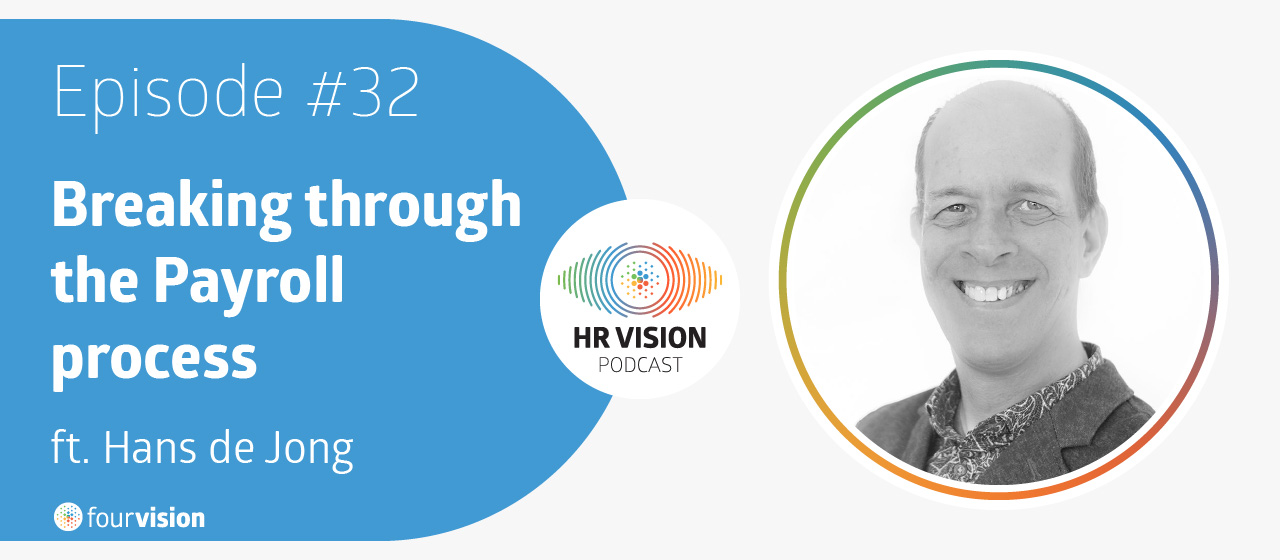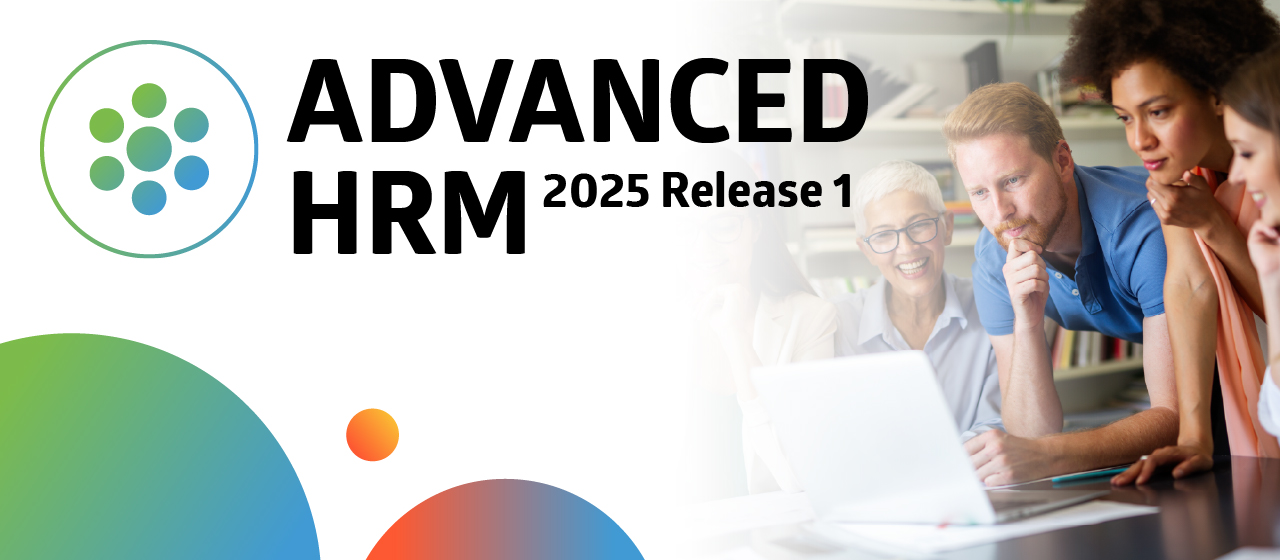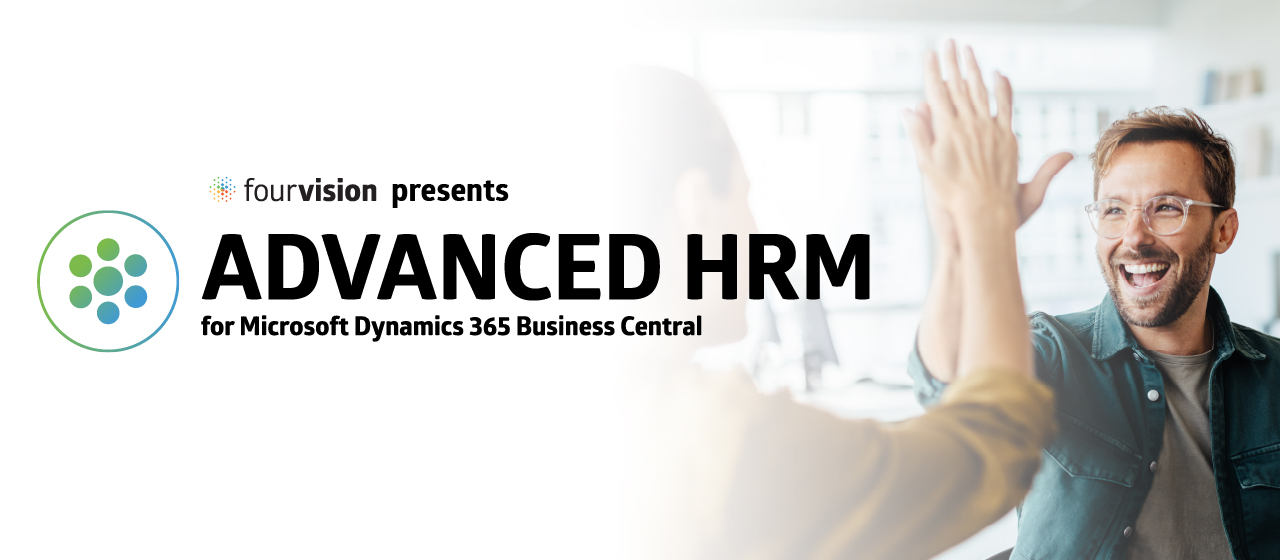Hans de Jong likes to wear many hats.
From political science to being with FourVision for almost 11 years, he’s a Sr. Consultant and our Payroll Interface Product Specialist. In this episode, we discussed his expertise in HR Tech and, especially, his most recent work as our Payroll product specialist. We broke through the complexity of the payroll process and how he and our team can help companies with their HR technology endeavors. It gets technical at times, but it’s worth it!
Ivo:
Hey, everyone, and welcome to the HR Vision podcast. I'm your host, Ivo, and every week I'm going to have a conversation that matters about HR. This week I have Hans de Jong with me.
Hans:
I'm fine. Thank you. Very good.
Ivo:
Good, good to have you here. Hans is a senior consultant at FourVision and our Payroll Interface product specialist. He is one of the most experienced members of our team he's been with FourVision for almost 11 years. And he has an extensive experience in HR technology. So this should be insightful I think. Hans, are you ready?
Hans:
Yes, I am.
Ivo:
Alright, let's get to it, then. Let's start like we start every time. Tell us about you, who are you? A bit of your experience in a nutshell. Of course, I know that the experience has been for some years in HR. So let us know.
Hans:
Yeah, well, I have a background with Dynamics for about 20 years now. I came from a technical wholesale company where I implemented Axapta to FourVision, where I work for 11 years now. So yeah, what I can say is, I started with the background, knowing the product. And at FourVision I started to learn more about HR. And over the years, I have a specialized in payroll specialized in leave functionality, time and attendance and sickness. In that I do a lot of things: implementations, customer support product development.
Ivo:
Okay. All right. Did HR start, you have a background on your studies, or around technology, around HR, how did that came about?
Hans:
Not at all. I'm originally a political scientist. I started a political science at the University in the Netherlands. Very long ago, I even did a traineeship at the United Nations Headquarters in New York. So my politics is still my big hobby, along with refereeing volleyball games. So that those are the two passions in my life: politics, following all the news in various countries. And volleyball is also a big hobby for me. The refereeing I'm doing for 32 years now.
Ivo:
Okay, and what happened there? Were you tired of politics? Like I prefer politics as a hobby. Let's fix on on HR first?
Hans:
Yeah. The thing is, when I came from the university, at that time the market to get a job was not so easy. So I was unemployed for a short while. And then I did some extra training and courses. And along with that came a traineeship at a technical wholesale company, in the IT department. And then I developed from just an IT member to tester, to the internal Solution Architect, Project Manager or system project manager, internal consultant. So in my previous job, I started to learn Axapta, I started to learn testing, describing functionality, doing workshops, making trading material and everything.
Ivo:
Okay. All right. I see. So it kind of happened a bit by by chance.
Hans:
Yes, exactly.
Ivo:
Alright, so first, let's still look back. What do you see? Like, what do you see since the beginning, since you start working with HR technology? What are the main things that you see changing in the past? I don't know, 20 something years already?
Hans:
Well, if I may say so for the thing I know most about which is Payroll.
The trends that I see happening: of course it's all developing into the cloud. That's one. Two, when it comes to payroll it is going extended to towards more near real time or real Time solutions like, API connections and not sending a file from an ERP system to a payroll system, but more on record level; sending individual records over in near real time, from one system to the other. So those are those are recent recent developments, many payroll vendors have had systems that required old often mainframe, and that's transforming into API and to some other technology more real time. that's basically what I see happening. And, there are many payroll vendors in the world, many paper systems in the world, we don't know all 200 countries in the world. We don't know all solutions in the world. But this definitely a tendency: towards clouds, API, other technology - not file-driven, with more real time.
Ivo:
More real time updates, okay.
All right. You work as well, in the in customer support in HR technology, my question to you is, what is it like? You know, what do you think are the must haves to be successful within that area?
Hans:
If a customer is live, and he has an issue, and then the issue goes to customer support. The customer support has to analyze and solve the issue. It is challenging, because it's different every time every customer is different, every person you're talking to is different. The setup is different, we have different products. So you have to you have to switch from product to product all the time. You know, it starts with having a template or a procedure that you work with.
And from there follow logical steps to analyze the issue, which usually starts with, please customer tell me: Which product, tell me in which environment you have the problem, tell me what is the version? Tell me what's the setup that you have? Tell me exactly what steps we should do to reproduce what issue you have? And then follow those steps. And then you got to come to okay, what's the problem? And is it setup? Or is it code? Or is it the procedure? Or is it data? Is it something else. And from there, you get to the point where you when to solution.
So it's very challenging, because it's changing sort of your your chair in your hat all the time. But at the same time, if you think illogical steps, if you follow a certain procedure, if you ask the right questions. Especially if you ask a lot of "why?", then you come to the solution.
Ivo:
Okay, so it's from what I understand is very important, the communication part. Also getting the context, getting to know what is the setup, what's everything behind it, before coming up with a solution or even understanding the issue there?
Hans:
Yes, yes. You know, if you have an issue, you always have to know the root cause. And if you don't know the root cause, you may come up with a solution that is a solution, but maybe not the right solution. So the most important thing is: you have to know the functionality, you have to have analytical skills, communication skills, and think in logical steps.
Ivo:
Yeah, I understand. And what gets you excited about it after all these years? Does it still get you excited? Working with HR technology, supporting customers?
Hans:
Yes, but what is so interesting about the job that it is so challenging, it's using your using your brain using your skills that you have, using your analytical skills. And each issue and each customer, like I said, is different, and that's what keeps what keeps you challenging. And I have to say, for me, the fun part is also that sometimes I do even sales demos, I do product development, I solve solutions for customers, I do a lot of testing. So, those things are all connected. Because in the end, if you solve a problem for a customer, that could also mean we have new the new ideas for product development. So selling a product, implementing it, going live solving,solving problems, new product developments. It is all interconnected.
Ivo:
Yes, I understand. Good. And, you just said it's very challenging a lot of times. So dealing with customers everyday, what are the most common challenges that you face with, with customers that at least you find like, the most common ones?
Hans:
Well, the most common one is the communication and writing down so that you know, and understand, the problem is in all the detail. Like I said, by going through the logical steps, but making sure that you can reproduce the issue and for reproducing the issue, you have to know which product, which version, which setup, which reproduction steps. So the logging in a ticket of all those details is very important. And do not go in the wrong way.
Ivo:
Yeah, so do you think customers sometimes face a challenge on their side as well, to try to communicate what the issue is? Do you think that happens?
Hans:
It happens on both sides. Sometimes the customer could be a little bit more clear, specific about exactly the issue. Whereas sometimes it's also internally that, that we need some more information from colleagues and that we need some more structural detail about okay, what exactly are we talking about?
Ivo:
And that poses a sometimes a time consuming task, if you don't really understand what the problem is and it isn't communicated well?
Hans:
Yeah, then you have to go back to the colleague or to the customer. Like "Hey, there's a piece missing really clearly understand what the problem is." Like I said, it's all in communication. And we are all humans. And that means that every time go to very little tiny steps, step by step, a one and a two and a three and etcetera. That's sometimes difficult to do that constantly, all the time. So it's, it's human to, yeah, to sometimes miss pieces of information or miss steps. But then: Yes, we have to make sure that the customer and reverse provision understand each other, have all the information to dig into what's the problem and come up with the right solution.
Ivo:
Alright. that's, that seems correct. Of course, you just said, you get excited by doing many things, not only customer support. You wear many hats, if we can we can say it like that. It's actually being our Payroll Interface product specialist. My question to you let's say, the listeners don't know the interface. My first question is, how does it work? You know, what does it do?
Hans:
What we currently have in Microsoft Dynamics 365 Finance & Operations, as well as a separate Payroll Web App is functionality to interface files. So at this moment, it's just file-based files from Finance & Operations to a payroll vendor. That means you do a setup, you make configuration sets of parameters. And then in the configuration, you have sets of fields that you can map, it's fully flexible.
You define a certain file type at this moment, we are supporting TXT and XML. So in the end the process is: you enter data in D365 Finance and Operations, you do a setup in the Payroll Web App with configurations with parameters and field mapping, with selection of a certain file type.
Then, based on the delta, so based on things that have changed. You send things over from D365 Finance and Operations via this Web App to a receiving payroll system. And why does it usually happen this way? Well, most ERP systems don't do payroll because you know, the legislations is different than every country sometimes even in a branch and type of organization. So, usually the concept is: you have to have something out of the Human Resources system/ERP system and let somebody else who specialized in it do the calculation about how much money is this worker going to get? What are the taxes, etc.
The key thing in our Payroll Solution is flexibility. Flexibility, and you can have many configurations, flexibility into: is it only changes or the full data dump. Flexibility in the file type, flexibility in the fields that you select that you want to be sent from one system to the other. And, yeah, that's basically it.
Ivo:
Okay, so you would say that the Payroll Interface Web App that we have, of course there's a payroll functionality, I guess, in the basic system of D365 F&O, Finance and Operations, right? And Microsoft Dynamics, but our Payroll Interface, what it does is adding more flexibility for more and better integrations with payroll vendors everywhere, or with a lot of them, I guess? Is that a correct assessment?
Hans:
Yes, yes. Because you know, like I said, what the Payroll Web App basically does is, so to speak, and interface app, to make sure that you add flexibility to cope with many different payroll vendors and many different payroll systems. By the way, I should add, I mentioned file based. But file-based can also be that we could act to do something that works based on APIs; Application Programming Interfaces. So file-based doesn't mean that we cannot cope it with modern technology. Only when it comes to are you working based on periods and making a payroll run, versus near real-time or real-time, there's a difference. There are things that still have to be have to be developed.
Ivo:
Okay, I see. It seems that payroll sometimes takes a lot of time to implement. Because you spoke about that complexity, that having different regulations even within the same country. Is that the only the only reason for it? Or is it also like a complex thing to explain to HR professionals sometimes, and they are the ones dealing with this, do you think?
Hans:
No. Most of the complexity comes from something else, which is a little bit technical, namely data structure. Just imagine that you have a payroll system, needing 100 different attributes from a worker in one single line in an Excel. Line 1 is employee 1 and line 2 is employee 2. 100 columns. And you have a certain data structure on the receiving side, So where the data goes to, but how the data structure looks in D365 Finance and Operations, so in which table these fields reside, is different. So maybe these 100 fields come from 20 different tables. And maybe these 20 different tables, depending on data structure, have different date effectiveness. So let's say that out of these 20 tables, we have not 20 different tables. Each have a date- and timestamp, so effective date and expiration date. But maybe we have five different date effectiveness for those 20 tables. So the combination of your file structure; "Okay, I need 100 fields in 100 columns", and two, to how many tables to which tables doesn't go in the receiving system and in which tables does it come from in the in the originating system? And how about date-timestamps? That usually makes it very, very complex.
Ivo:
Yes, I can, I can understand that. It is also a problem of different vendors have different systems have a different language and the complexity comes from aligning those languages.
Hans:
In short, a difference in data structure and difference in date effectiveness. That usually makes it very complex.
Ivo:
I get it, I get it. We call our Payroll Interface. My question to you is, what does that interface part mean? Is it just a data integration? Or is the user interface the Web App?
Hans:
The Web App is also a user interface because you know, you have an app with a GUI. So as a user, you have friendly screens, where you can a: make the setup. So you can make and enter configurations. And the configuration is like an ID and a name and then you can set up parameters - "click, click click" and you set parameters. In that GUI, you also set up your fields that you want to get across. So you do the field mapping, and you create your payroll runs, that means, you have a certain open payroll run. And then you go to a screen and you say, and I want to start the panel, I want to schedule a payroll go to be executed later, or I want to set up a certain batch to that payroll runs are going to be created automatically with a certain interval. Those are things that you can do in the Payroll Web App.
So it's not just under the hood, technical that the user doesn't see. No, you have actually an app where you can go into as a system administrator to set up these configurations. As a payroll manager, okay to conduct creating payroll runs, and to view the results before you say now it's good. And now I'm going to the payroll vendor.
Ivo:
Okay. That's clear. Of course, this is a kind of, for the listeners is kind of a biased question on the Payroll Interface. But why do you think people should not only keep the payroll features that comes out of the box with Microsoft Dynamics, but add the Payroll Interface, that FourVision has?
Hans:
Well, basically, because it's very flexible. And it can cope with many different many different payroll vendors. So it is an out-of-the-box thing, which means you can minimize customization. And by the way, if you look at the new development of Microsoft with product fusion, going back from Dynamics HR to integrate it back into D365 Finance and Operations. Means that I believe, for example, the Ceridian standard Microsoft interface is not going to be continued as far as I am informed.
And that means that you know, people need an alternative. And then you have something out of the box that connects to the new Finance/Operations, so Dynamics 365. After incorporating HR back into back into the ERP, you have an out of the box solution, which is flexible, which can cope with, for example, Ciridian customers, and many others. To minimize, or to even get rid of customization or minimize customization, because I'm not saying that you always can guarantee 100% fit, like I said, every payroll system is different. I've seen so many different varieties, but at least, having a big challenge of having no customization or minimum customization.
Ivo:
Alright, that's, I think that's pretty clear. All right. One last question for you. Regarding the future. You already mentioned the cloud and the API integrations and the market going more towards that. Is there any any other eastern interesting HR tech trends that you see coming?
Hans:
No, from my side not. There's so much going on that I may not know everything. And like I said, I'm very much specialized in payroll and also leave and sickness and time and attendance. So I am not aware of all the trends that are going on, I focus mainly on payroll. So no, at the moment...maybe after this call, I think yeah, this or this, that maybe something comes up. But the one the things that are already mentioned are the ones that are on the on the tip of my tongue.
Ivo:
Okay, let me ask you the question a different way for payroll. Of course, we already talked, it's moving towards the real time communication integration. Do you think for payroll and Payroll Interface, do you think systems will be simplified? I mean regulations for countries or that will continue? And have you seen that change in some countries simplifying it, so payroll gets easier? Did you see that at all? In your experience?
Hans:
No, because? No, because you know, the complexity lies in the difference between between countries, each country has its like, legislation. So maybe maybe there are some countries that are changing some legislation. Yeah, that could happen. And I don't know all the countries in the world and all their tax regulations. But for us, as FourVision and maybe for our partners, if you do an implementation, often it is across borders of countries. So often, the partner has a customer that does business in many countries, dealing with sometimes even different payroll vendors, or at least different regulations in different countries. So for example, yeah, we have a prospect having a customer. That customer does business in South Africa, and in the UK and in Ireland, and then the many other countries. And then you have you have different legislation.
So even even when in the country things in the legislation of one country things are changing, then you still have complexity, because you're dealing with many countries.
Just one other thing that comes that crosses my mind is that I think that HR technology became more important during or after, you could say during COVID. I really believe believe that there is more need for HR automation. After the, the phase we are in or we just had.
Ivo:
Yes. Because people are far apart from each other. They were removed, and suddenly you don't know which people are where and all that, right?
Okay, Just one last thing still about change, leave and absence? I'm just curious, because you also have experience with that? Did you see it change it a lot? Or it's just, again, API's and those real time connections? In terms of functionality, I mean.
Hans:
yeah, okay. But when we talk about Leave & Absence, I'm not talking about interfacing, we are talking about functionality for the customer to administer and to register their leave and absence.
Again, what I see there is that it differs very much from country to country, from branch to branch, even from organization to organization. You know, you have countries and organizations, where you get, for example, leave entitlement upfront at the beginning of a period, and sometimes you get it at the end of the period. Sometimes you carry sometimes you do carry over from month to month. So what you haven't used for this month goes to next month, and sometimes you do you do carry over from year to year, or sometimes you don't do carry over, leave entitlement at all. So, in leave of absence also, there's a big difference and in how it gets dealt with it, for example, USA and Canada versus Europe.
Or think about if you are sick Are you then still accruing. So building up leave entitlements or not. So it's not so much changes that you see. It's not about interfacing but it's about different legislations about how to deal with entitlement, what happens when you're sick, with your leave entitlement. How do you accrue, when do you accrue, how much do you accrue? It's different everywhere.
Ivo:
Yeah. Another thing that has a lot of complexity. Yeah. And it might seem simple enough, because it's one of the basic HR processes that you have, but it has a lot of complexity depending on country and region. All right. Maybe a conversation for another time, the Leave & Absence.
Hans, thank you so much for coming on the podcast. I really appreciate the time. I hope you enjoyed it.
Hans:
Yes, I did. And I hope it's useful for the listeners. If they have questions and want to reach out to FourVision, they will know how to find us.
Ivo:
Yes absolutely. Thank you Hans for taking the time, I really enjoyed it. For the listeners out there, I hope you enjoyed it too. See you next time.
Sign up to receive email updates
Enter your name and email address below and I'll send you periodic updates about the podcast.







